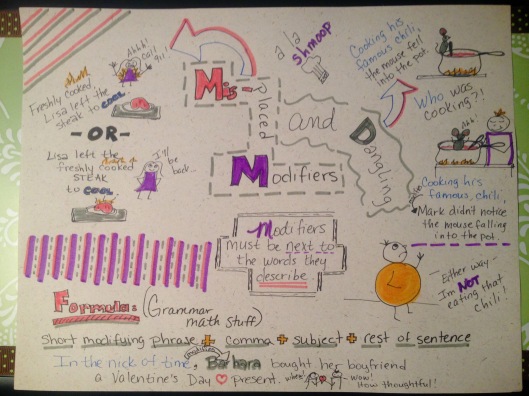
King Cake
Happy Mardi Gras, y’all! I never thought living up here in Tennessee would ever result in having Mardi Gras day off like I did back home, but thanks to a winter storm, we managed to get just that! I could have spent it grading papers, and I probably will before today is out, but it just wouldn’t have been a proper Mardi Gras without King Cake!
By now, you may have gathered that I do things a little more out of the box than some, and my king cake is no different. I start off with a traditional recipe from good ol’ Betty Crocker. Then, I start making it my own. For starters, I use a whole stick of butter in my dough instead of what that recipe calls for. Here’s a picture walk of how I do it.
Follow the bread making recipe as usual (except for the extra butter) through the step where you roll it out. While it’s doing it’s first rise, I make my fillings. I do the standard cinnamon sugar, but then I make a cream cheese filling, too. Here’s the recipe for that:
2 packages cream cheese softened
1/2 cup powdered sugar
1/2 teaspoon vanilla extract
Mix together until creamy. I use my stand mixer and the flat paddle on slow speed.
Using a zip top bag and a mug to help hold it open, make a piping bag.
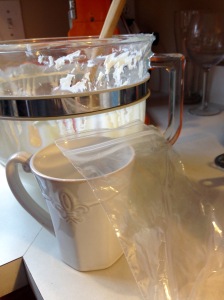
A coffee mug helps hold the bag open so you can spoon the thick heavy mixture inside.


Spoon the cream cheese mixture in carefully.

Remove the bag from the mug and work out as many air pockets as you can then zip closed. Ta-da!

And there you have it. Just cut the corner off and you’re ready to go.
Once your fillings are ready to go and your dough has doubled in size, it’s time to roll it out. I have a large cutting board that I use, but use whatever large surface you have. Somewhere I have a rolling pin, but I have no idea where, so I improvised. I love mason jars and use them for all kinds of things.

Dough once it has doubled in size.

A mason jar doubling as a rolling pin.
Roll the dough out as instructed in the recipe. Spread your cinnamon sugar filling out over a portion of the rolled dough, then pipe on the cream cheese filling. It’s pretty thick, so you’ll want a good sized hole. Don’t squeeze too hard all at once or you will pop the top of the bag open. (I know. I did it.)

Gently squeeze your home made piping bag, then just toss it out once you’re all done. Love easy clean up.
Then, start rolling it up, jelly roll style.


I decided to do part of the dough as a traditional ring cake, and the other half as individual cakes in large muffin tins. So, I cut the rolled log in half. I started with the ring cake, so I placed the other part back in the greased bowl it was rising in.
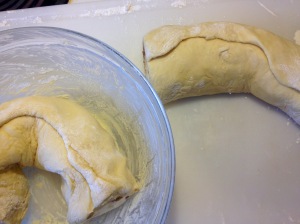
Roll the dough out like you would a play dough snake, making it longer and thinner. Work slowly and gently so you don’t tear the dough. Pinch the ends of the dough to seal in the filling, shape into a ring and place on a greased cookie sheet. Cover in plastic wrap and allow to rise again for 1 hour, or until doubled in size.

Rolled, shaped, and ready for the second rise.
Now you’re ready to work with the other half. Make a long snake with it again, only this time, you will cut it into 12 pieces (like a sushi roll.) Pinch the ends of each one closed as much as possible. You can pull on the dough a bit to help get it around the filling. Place the dough balls into greased muffin tins. Cover with plastic wrap and allow to rise.
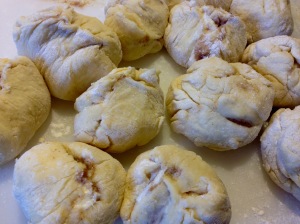
After working the dough out to a longer roll, slice it sushi style, then pinch the ends closed as much as you can. I rolled them around on the floured board to keep them from sticking to my hands as much. This is a moist dough and may get a little tacky as you work with it in your warm hands.

Before the second rise.

After the second rise.
Time to bake them up! Both the ring and the mini cakes can go in the oven at 350 degrees for 20-30 minutes, depending on your oven.
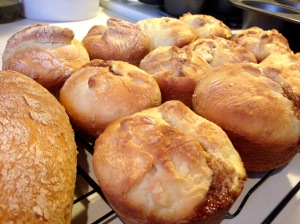
They would be fabulous like this. Little brioche pockets. But, this is carnival time, so they need a little dressing up!
When they are golden brown, take them out and put them on a cooling rack. Let cool completely before icing.
**If using the icing recipe from Betty, you will need to double it in order to have enough. I added a tad more milk to mine to make it thin enough to drizzle on top of the cakes.
Then sprinkle on some colored sugar in traditional Mardi Gras purple, green, and gold!

Looking festive in their Mardi Gras colors. Personally, I could have these all the time and just not put the colors on. You could add extracts to the icing to change them up a bit. Why not lemon, almond, or orange? Yum! Sprinkle on some sliced almonds to dress them up, or add walnuts or pecans in with the filling. So many ways to make these your own! My son is away at school and is sad because he can’t have any. So, when he gets home for spring break, I told him I would make him Spring Cakes. 😉
Happy Mardi Gras, teachers! Enjoy the day and laissez les bon temps rouller!
 To see how the pros do it and to get some inspiration, be sure to check out The Sketchnote Army site and Mike Rohde, or take a look at some of the beautiful work done by Allison Kimball in her sketchbook. Or just google it. Remember – it’s about the ideas, not art.
To see how the pros do it and to get some inspiration, be sure to check out The Sketchnote Army site and Mike Rohde, or take a look at some of the beautiful work done by Allison Kimball in her sketchbook. Or just google it. Remember – it’s about the ideas, not art.


